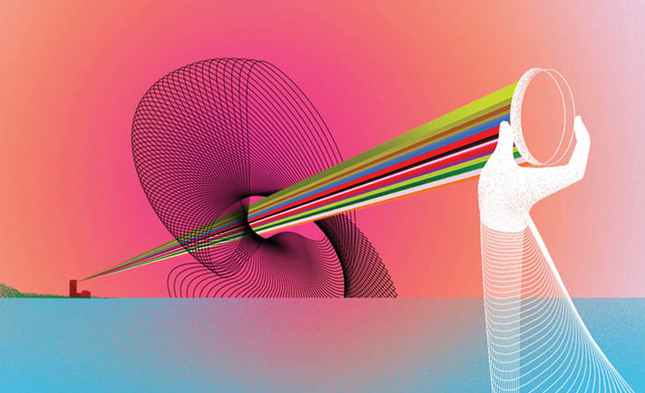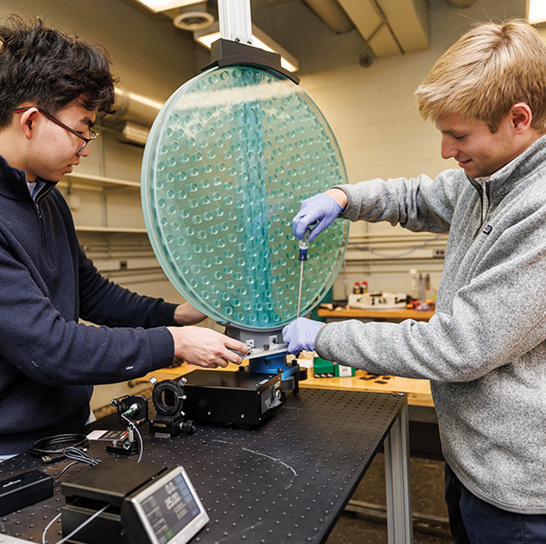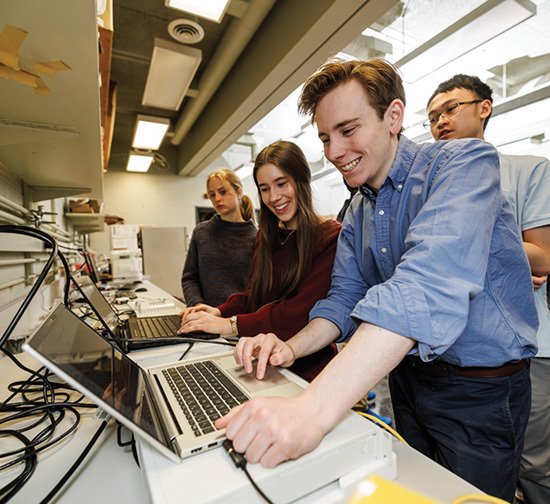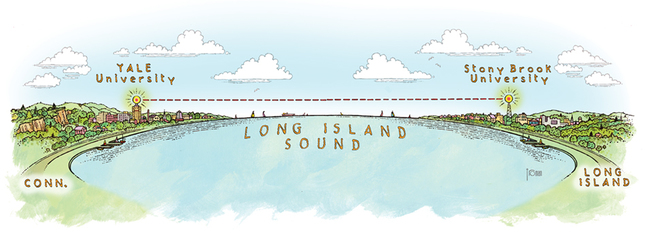
Brian Stauffer

Brian Stauffer

Tony Fiorini
Christian Kang ’26 (left) and Alexander Morand ’26 mount a 25-inch telescope mirror to a rotating frame.
View full image

Tony Fiorini
Christian Kang ’26 (left) and Alexander Morand ’26 mount a 25-inch telescope mirror to a rotating frame.
View full image

Tony Fiorini
Four members of the Q-LATS undergraduate research team prepare the laser system for a free-space timing distribution test. From left to right: Isabella Farrow ’26, Rebekah Citsay ’27, Jeb Cui ’26, and Mason Abrell ’26.
View full image

Tony Fiorini
Four members of the Q-LATS undergraduate research team prepare the laser system for a free-space timing distribution test. From left to right: Isabella Farrow ’26, Rebekah Citsay ’27, Jeb Cui ’26, and Mason Abrell ’26.
View full image

John Roman

John Roman
The laser travels south over the waters of Long Island Sound, over the bluefish and terrapin, the phragmites, rockweed, fiddler crabs, and phytoplankton. It speeds overhead invisible to the life and world we know, from the highest point on Yale’s campus in New Haven to the highest point of Stony Brook University on Long Island, where, if all works as it should, the beam of light delivers information to distant quantum computers in the form of entangled photons.
That’s the vision for Quantum Laser Across the Sound, dubbed Q-LATS, a project in the works from the lab of Yale professor Hong Tang, an engineer who researches quantum systems and the kinds of networks needed to link these systems together.
Since its beginning, Q-LATS has been under the guidance of a team of undergraduates, now a 12-person crew that Tang describes as “very enthusiastic.” Perhaps none is more enthusiastic than Mason Abrell ’26, a senior with a double major in physics and global affairs. Abrell joined the quantum computing club freshman year and was copresident last year. As a sophomore, he and his team won the MIT Quantum Hackathon; he then went on to develop quantum financial algorithms while interning at Moody’s.
He first started working in Tang’s lab in the fall of 2023, assisting with materials science research related to quantum computer chips. He remembers sitting in Tang’s office one spring day in 2024, a few weeks before commencement, talking about his work to that point and about how he might apply his efforts in the future. Tang then offhandedly mentioned an idea he’d long relegated to the back burner, something neither he nor his grad students or postdocs had found time to work on. For this nascent idea, though, Tang was applying for funding from the National Science Foundation. Perhaps Abrell could lend a hand? Tang was interested in attempting to craft a technology capable of communicating quantum information through free space, as opposed to fiber optic cables, using lasers fired between two telescopes.
“And I was like, ‘lasers’?” Abrell recalled.
Most fundamentally, a connection like this would allow quantum computers to operate on a network, the same way classical computers use the internet to connect with one another. And while fiber cables are able to carry quantum signals, existing infrastructure is not designed to do so, which means a new, parallel fiber network would need to be built. That’s expensive. Sending information through lasers bypasses the need for such costly hardware; it also allows communication with locations inaccessible by cable—moving boats, for instance, or objects in space.
A handful of research groups around the world are working on this challenge, and such a possibility is terrifically exciting to Abrell. Before he got involved in the project, when giving a presentation to members of the quantum computing club, he would invariably include a slide or two with schematic drawings of these types of free-space links—lasers stylized as colored lines tethering together two orbital satellites, or an orbiting satellite to a ground-based terminal. Now he was being tasked with developing this technology? He stepped from Tang’s office and called six of his friends, “all huge quantum networking nerds.” He asked if they wanted to be involved.
Christian Kang ’26, a senior majoring in physics, remembers getting the call. He had already had some experience working in Tang’s lab, performing small tasks on a well-defined project the summer before. That was, Kang says, the standard experience for undergraduate research assistants. “Typically, as an undergrad, you’re given one minor piece of some grad student’s work and you’re asked to solve a narrow problem,” Kang says. “In this case, Dr. Tang handed over the entire project and told us to figure it out.” Kang signed up.
The first Q-LATS meeting consisted of Abrell and five others in the basement of Bass Library, writing down as many names they could of people who might be interested in joining and who would have the mix of skills needed to pull off the project—Ocean’s Eleven meets Science Olympiad. They needed computer scientists for coding, electrical and mechanical engineers for design, and environmental scientists to help model interactions as the lasers angled over the Sound. They filled a chalkboard with candidates, then fanned out to pitch the idea.
“After that, we had our first big meeting with everyone we’d recruited and it was absolutely chaotic,” Abrell says. The problem before them was large. Lots of voices were weighing in and it was difficult to know where to start. But slowly, a path emerged. People split into teams and the project, divided in parts, became tractable. “We’ve come a long way.”
With a mix of borrowed and original ideas, the team has created a model of the telescope that is theoretically capable of sending quantum information across the Sound. The mechanics of the idea are relatively straightforward. Some time down the road, when the telescope at Yale is constructed and installed and its partner telescope at Stony Brook across the water also constructed and installed, the process of transmitting quantum information would begin with a small dome atop Kline Tower sliding open and rotating into position. The first of three lasers, the beacon beam, would switch on. Though nothing would be visible (it’s infrared), this laser would bounce back and forth between Stony Brook and Yale in a process designed to precisely align the telescopes’ mirrors. The second laser, a timing beam, would emit a specific sequence of pulses used to synchronize clocks on both sides. Finally, the quantum beam would switch on, generating entangled pairs of photons and sending one half of these pairs to Stony Brook, where they would be routed downstairs to a quantum computer. The other half of these photons would stay in New Haven.
“Spooky action at a distance” is how Einstein described entanglement. It’s a principle central to quantum mechanics in which two particles, no matter the distance between them, remain tied together. Take a pair of entangled photons, keep one on Earth, send the other to a distant galaxy. While unobserved, both photons exist in several states simultaneously: they are both horizontally and vertically polarized, for example; they possess many energies at the same time. This is the quantum property of superposition, most famously captured by Schrödinger’s cat, an animal both dead and alive until the top of the box is lifted.
But observation changes this. Once someone on Earth looks at the photon, its energy level and polarity become fixed. The entangled photon in a galaxy light years away also collapses into a fixed and known state. Measuring one instantaneously reveals measurement of the other.
Connecting computers through entanglement promises a handful of well-known applications. Telescopes like the one designed by Q-LATS, for instance, may one day allow people to network into a quantum computing cluster for research, the same way they can remotely access classical supercomputer clusters today. Quantum communication also presages breakthroughs in cryptography and secure information transfer, which is one of the reasons the financial sector and the military are heavily engaged in this research. (Professor Tang works in partnership with the Air Force Research Laboratory—AFRL—on several projects.) But the value of this work, the scale of its effects, will only come into focus down the line, as quantum computing and communication technologies mature. The field remains very young.
“There are still a lot of open questions in the community,” says Nicholas Lanning, a research physicist at AFRL who leads a free space quantum team.
The telescope will not be done this year, or next. Working through the technical challenges will take several generations of students, each one handing increments of progress to the next. The timeline could be five years. It could be a decade. Perhaps more.
Alexander Morand ’26, a senior majoring in mechanical engineering and physics, has been on campus this past summer coaxing the project along. He is running “very short range tests,” he says, calibrating the alignment and timing of lasers over a few centimeters, after which he’ll move on to a few meters, and then a few dozen meters. It is 48 kilometers over the water from Yale to Stony Brook. The mirror that they are targeting is 25 inches in diameter.
Aiming the lasers such a distance with such precision requires isolating the telescopes from vibration and carefully tuning their position with piezoelectric motors. It also requires accounting for environmental perturbations: air turbulence and humidity; fog and rain; beam diffraction and distortion.
Creating a sufficiently sensitive detector is another key challenge. The information that the team is transmitting is embedded in individual pairs of photons, which means the Q-LATS team needs a way to parse the arrival of a photon from other noise on the detector, like listening for a succession of very, very light taps on a window. “There are single-photon detectors out there, but they aren’t really in our budget,” Kang says. “So if we can’t have that, we’re working out what it is we can do.”
This question of detection speaks to a third, related challenge: timing. Individual, entangled photons will arrive from one telescope to the other in pulses that are nanoseconds apart (that’s billionths of a second). For linked quantum computers to perform operations using these photons—to join two quantum computers in a network—clocks between these computers must be synchronized down to roughly ten picoseconds, or ten trillionths of a second.
This is not a timescale in which people, or people’s minds, comfortably sit. In the same way geologic epochs ultimately reside on a plane beyond our reckoning, quantum time, too, is unfathomable. In three picoseconds, light travels roughly one millimeter. The Q-LATS team is trying to devise clocks synchronized to the length of time it takes light to travel three millimeters. That’s a quick snap, a sudden jiffy, a blip.
But, for Abrell and his teammates, these seemingly insurmountable challenges are just part of the fun. It’s like “being a kid in a candy store,” Abrell says, “though I’m always responsibly using lab funds.” He’s particularly charmed by the challenge of timing synchronization over long distances, but he is also motivated by the project’s grander dynamics, the sense of being part of something large. He and his classmates present their research at conferences; they meet with preeminent peers from other institutions; they are, he says, taken seriously by scientists with far more experience and expertise.
“This has been an opportunity unlike any other for undergrads at Yale, or even nationally,” he says. “To take such agency in a project of this scale . . . ” He trails off, the word hanging there, ringing with delightful ambiguity. Both big and small. Abrell did not elaborate. A notion caught in superposition.
 loading
loading